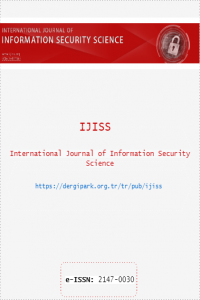Scale development/adaptation studies conducted within the scope of cyber threats and information security issues
Scale development/adaptation studies conducted within the scope of cyber threats and information security issues
Information security, Cyber security, Awareness Perception, Risk,
___
- [1]. C. Tosun, and Y. Taşkesenligil, “The instruments used in science education in Turkey: a descriptive content analysis”, Abant İzzet Baysal University Journal of Faculty of Education, 15(2), 364- 383, 2015.
- [2]. E. Stone, Research methods in organizational behavior. Glenview, IL: Scott, Foresman. 1978.
- [3]. E. Mor Dirlik, “The Analysis of the Doctoral Dissertations Themed of Scale Development According to the Test and Scale Development Standards" Journal of Measurement and Evaluation in Education and Psychology, 5(2), 62-78. 2014.
- [4]. R. F. DeVellis, “Scale development theory and applications”, (Second Edition). SAGE Publication, Inc. 2003.
- [5]. N. Antoniadou, C.M. Kokkinos, and A. Markos, A. “Development, Construct Validation and Measurement Invariance of the Greek Cyber-Bullying/Victimization Experiences Questionnaire (CBVEQ-G)”, Computers in Human Behavior, 65, 380-390. 2016.
- [6]. G. Kaya Uyanık, N. Güler, G. Taşdelen Teker, and S. Demir, “Investigation of Scale Development Studies Conducted in Educational Sciences Published in Turkey by Many-Faceted Rasch Model”, Journal of Measurement and Evaluation in Education and Psychology, 8(2), 183-199. 2017.
- [7]. A. Anastasi, Psychological testing, (6thEd.). New York: MacMillan Publishing Co. Inc. 1988.
- [8]. R.L. Linn, and N.E. Gronlund, Measurement and assessment in teaching, Seventh edition. New York: Macmillan. 1995.
- [9]. L.J. Cronbach, Essentials of psychological testing, (5th Ed.). New York: Harper Collins Publishers.1990.
- [10]. R. Edenborough, Using psychometrics:a practical guide to testing and assessment, London: Kogan Page. 1999.
- [11]. M. Acar Güvendir, and Y. Özer Özkan “The Examination of Scale Development And Scale Adaptation Articles Published In Turkish Academic Journals On Education”, Electronic Journal of Social Sciences, 52, 23-33. 2015.
- [12]. R.J. Cohen, and M.E. Swerdik, Psychological testing and assessment, Boston: McGraw-Hill Companies. 2010.
- [13]. L. Crocker, and J. Algina, Introduction to classical and modern test theory, New York: Holt, Rinehart and Winston, Inc. 1986.
- [14]. H. Keser, and C. Güldüren, “Development of Information Security Awareness Scale”, Kastamonu Education Journal, 23(3), 1167-1184. 2015.
- [15]. T.R. Hinkin, “A review of scale development practices in the study in organizations”, Journal of Management, 21(5), 967-988. 1995.
- [16]. R.L. Worthington, and T.A. Whittaker, “Scale development research: A content analysis and recommendations for best practices”, The Counseling Psychologist, 34(6), 806-838. 2006.
- [17]. A. Slavec, and M. Drnovsek, M. “A perspective on scale development in entrepreneurship research”. Economic and Business Review, 14(1), 39-62. 2012.
- [18]. S. Çüm, and N. Koç, “The Review Of Scale Development And Adaptation Studies Which Have Been Published In Psychology And Education Journals In Turkey”. Eğitim Bilimleri ve Uygulama, 12 (24), 115-135. 2013.
- [19]. E. Tavşancıl, G. Güler, and C. Ayan, “2002-2012 yılları arasında Türkiye’de Geliştirilen Bazı Tutum Ölçeği Geliştirme Çalışmalarının Ölçek Geliştirme Süreci Açısından İncelenmesi”. IV. Ulusal Eğitimde ve Psikolojide Ölçme ve Değerlendirme Kongresi, 9-13 Haziran, Hacettepe Üniversitesi, Ankara. 2014.
- [20]. A. Delice, and Ö. Ergene, “Investigation of Scale Development and Adaptation Studies: An Example of Mathematics Education Articles”. Karaelmas Journal of Education Science, 3(1), 60-75. 2015.
- [21]. Ş. Gül, and M. Sözbilir, “Thematic Content Analysis of Scale Development Studies Published in the Field of Science and Mathematics Education”. Eğitim ve Bilim, 40(178), 85-102. 2015.
- [22]. M.G. Şahin, and N. Boztunç Öztürk, “Scale Development Process in Educational Field: A Content Analysis Research”, Kastamonu Education Journal, 26(1), 191-199. 2018.
- [23]. R.Y. Kıncal, Bilimsel Araştırma Yöntemleri. Nobel Akademik Yayıncılık. Ankara. 2013.
- [24]. M. Taşdemir, and A. Taşdemir, “Scientific Research Review Competences of Prospective Teachers”. Selcuk University The Journal of Institute of Social Science, (26), 343-353. 2011.
- [25]. N. Karasar, Bilimsel araştırma yöntemleri, (17th edition). Ankara: Nobel Yayıncılık. 2007.
- [26]. A. Erkuş, “Ölçek geliştirme ve uyarlama çalışmalarında karşılaşılan sorunlar”, Türk Psikoloji Bülteni, 13 (40), 17-25. 2007.
- [27]. Gartner. https://www.gartner.com/smarterwithgartner/ 5-trends-emerge-in-gartner-hype-cycle-for-emergingtechnologies-2018, accessed: 06 Mart 2019.
- [28]. R.K. Hambleton, and L. Patsula, “Increasing the validity of adapted tests: Myths to be avoided and guidelines for improving test adaptation practices”, Journal of Applied Testing Technology, 1(1), 1-30. 1999.
- Yayın Aralığı: Yılda 4 Sayı
- Başlangıç: 2012
- Yayıncı: Şeref SAĞIROĞLU
SLAAC Attack Detection Mechanism
Nazrool Bin OMAR, Selvakumar MANİCKAM
Incorporating Differential Privacy Protection to a Basic Recommendation Engine
A Description Logic Ontology for Email Phishing
Franklin TCHAKOUNTÉ, Djeguedem MOLENGAR, Justin Moskolai NGOSSAHA
Enhancing Network Security for Image Steganography by Splitting Graphical Matrix
